- Quick Read
- Deep Read ( 6 Min. )
Monitor Daily Podcast
- Follow us:
- Apple Podcasts
- Spotify
- RSS Feed
- Download
TODAY’S INTRO
How a Missouri parent used respect to stand up for his trans daughter
In March, a lawyer named Brandon Boulware delivered a speech that has over 7 million views on Twitter. He wasn’t in court. He was asking Republicans in the Missouri state legislature not to ban his 12-year-old transgender daughter from playing sports with other girls.
Mr. Boulware says he sought to forge a persuasive connection with the lawmakers.
“I’ll treat others how I’d want them to treat me. And that, of course, is with respect,” says Mr. Boulware in a phone interview. “No matter what our preconceived notions are about people or their positions, their attitudes, etc., you have to hear people out, because so many times what we assume is true about someone and their beliefs is not.”
Mr. Boulware’s approach offers a model for civil discourse – regardless of the particular issue at hand. He led with humility. For years, he admitted to lawmakers, he didn’t understand transgender issues either. He’d been slow to embrace his daughter. Once he did, his once miserable kid blossomed into a happy one.
“The part that resonates with people the most is his willingness to admit that he was not accepting,” says Missouri state Sen. Greg Razer, an openly gay Democrat. “I think far too often – and not just on this issue – progressives and liberals like to demonize people for not accepting instantly. And we need to give people time.”
The bill in Missouri will be decided in the fall. Mr. Boulware hopes he’s started a productive conversation by focusing on common values he shares with his adversaries, such as his Christianity.
“The most critical commandment that Jesus gave to his disciples was, ‘Love one another as I have loved you,’” he says. “If you remind people of that, the walls that we put up, they start to crumble.”
Share this article
Link copied.

Help fund Monitor journalism for $11/ month
Already a subscriber? Login

Monitor journalism changes lives because we open that too-small box that most people think they live in. We believe news can and should expand a sense of identity and possibility beyond narrow conventional expectations.
Our work isn't possible without your support.
Why more Democrats are pressing Biden to support Palestinian rights
A shift within the Democratic Party has eroded its support for Israel in its handling of the Palestinian conflict. That shift has put a spotlight on the weight of human rights in President Biden’s foreign policy.

President Joe Biden came into office vowing to make human rights an integral plank of his foreign policy. The latest flare-ups in the Israeli-Palestinian conflict, and the international reaction to perceived Israeli overreach, are putting a spotlight on that foreign policy.
Critics in the Democratic Party, particularly on the left, have grown impatient with unwavering U.S. support for Israel and are questioning why more attention isn’t given to Palestinian rights. This shift is partly generational and reflects the greater diversity among Democrats in Congress. But even New Jersey Sen. Bob Menendez, a Democrat and longtime Israel ally, has chided Israel for its actions in Gaza.
Analysts say President Biden has shifted his rhetoric on the conflict by speaking of Palestinian democracy and freedom. But that doesn’t mean he’s about to change fundamentally how he sees the conflict or the U.S.-Israel alliance. Veteran U.S. diplomat Dennis Ross says of the president, “He had a very clear sense of what was right and what wasn’t right, and he was pretty consistent in sticking by that.”
Why more Democrats are pressing Biden to support Palestinian rights

For decades, the Democratic Party has stood by Israel in times of war and peace.
Today, that support no longer looks so solid. In the Democratic-controlled Congress, more lawmakers are calling out Israel for its actions in its latest conflict with Hamas that ended in a cease-fire last week. And this poses a dilemma for President Joe Biden, a staunch ally of Israel who has vowed to make human rights a priority, not an afterthought in his administration.
On May 15, after the U.S. blocked United Nations efforts to seek a cease-fire in Gaza, where Israeli airstrikes had leveled residential buildings in retaliation for Hamas rockets, New York Rep. Alexandria Ocasio-Cortez, a Democrat, issued a caustic tweet. “If the Biden administration can’t stand up to an ally,” meaning Israel, “who can it stand up to? How can they credibly claim to stand for human rights?”
Ms. Ocasio-Cortez and other Democratic critics say the United States looks hypocritical for standing unwaveringly by Israel even as it took actions in Jerusalem, the West Bank, and Hamas-controlled Gaza that a mounting international chorus condemned as gross violations of Palestinian rights.
And it’s not just firebrands in Congress who are challenging Mr. Biden to steer away from a traditional “Israel first and unquestioned” approach to the Israeli-Palestinian conflict and toward a more nuanced and balanced approach that puts human rights at the fore.
Democratic Sen. Bob Menendez of New Jersey, chairman of the Senate Foreign Relations Committee and a longtime staunch Israel supporter, issued a statement on the same day as Ms. Ocasio-Cortez’s tweet. He called out Israel for “the death of innocent civilians” and for targeting a Gaza high-rise in which international media outlets had offices.
Taken together, this amounts to a wake-up call for the White House that the Democratic Party has now shifted on how it sees the Israeli-Palestinian conflict and the U.S. role in addressing it.
“What we’ve seen over the past two weeks is a tectonic shift in the American approach to the Israeli-Palestinian conflict, and primarily from Congress, away from the standard ‘I stand with Israel’ response to a focus on the human rights and inalienable rights of the people suffering in this,” says Hadar Susskind, president of Americans for Peace Now, a Jewish organization supporting both Israel and an equitable settlement of the conflict.
“No one is saying that standing with Israel is a bad thing,” he adds, “but rather that the same response people have given for 30 years in these situations is not a whole answer in terms of what we’re doing on the ground to make things better for Israelis and Palestinians alike.”

Greater sympathy in Congress
The shift reflects a set of domestic factors, ranging from a more diverse class of Democratic members of Congress more sympathetic to the Palestinian cause and young American Jews willing to be more critical of Israel, to a backlash to President Donald Trump’s “Israel yes, Palestinians no” approach.
For some, a year of U.S. and indeed global focus on issues of race and institutional discrimination following the death of George Floyd has also placed a new spotlight on the inequalities facing Palestinians living under Israeli occupation.
But Mr. Biden’s own emphasis on human rights and values like freedom and self-governance has also played a role in encouraging the trend, some political analysts say.
On Monday, more than 500 Biden campaign workers and Democratic staffers in Congress and elsewhere sent the president an open letter “imploring” him to “hold Israel accountable for its actions and lay the groundwork for justice and lasting peace.”
The signatories then added, “The very same values that motivated us to work countless hours to elect you demand that we speak out.”
A rhetoric shift
At the same time, the shifting American outlook reflects a perspective gaining ground in Congress and elsewhere that unquestioned U.S. support, particularly under President Trump, has only emboldened Israeli Prime Minister Benjamin Netanyahu to steamroll Palestinian demands for greater rights and justice.
The question now, some analysts say, will be to what extent Mr. Biden will temper his support for Israel in order to incorporate the views of young progressives in his party. Last month, he promised to restore $235 million in aid to Palestinians that Mr. Trump had cut off. That was before the 11-day war erupted in Gaza after weeks of rising tensions in East Jerusalem over the eviction of Palestinian families.
Some already see evidence of a significant shift in Mr. Biden’s rhetoric. When he welcomed last week’s Israel-Hamas cease-fire, he used language that diplomats with long experience in Middle East affairs say carries weight in the region. “I believe the Palestinians and Israelis equally deserve to live safely and securely and to enjoy equal measures of freedom, prosperity, and democracy,” Mr. Biden said on May 20.
That reference by a U.S. president to equal treatment of Israelis and Palestinians may end up being remembered as the hallmark of this crisis.
“For the first time we have a president of the United States talking about equal [rights] ... that Palestinians and Israelis should enjoy equal measures of freedom, security, dignity, and so on,” said Martin Indyk, a former U.S. ambassador to Israel and former assistant secretary of state for Near East affairs, speaking Friday at a Council on Foreign Relations event.
“That word ‘equal,’” he added, “is a sign for me that the argument about rights, rather than about a two-state solution, is what is emerging from this crisis.”
A consistent Israel ally
Some critics of Israeli policy saw Mr. Biden’s reference to Palestinian freedom and democracy as an unusually strong swipe at its occupation of the West Bank. But others with close knowledge of Mr. Biden’s thinking caution against expecting any significant change in his outlook.

“Having seen Biden in action ... and especially on these issues, he had a very clear sense of what was right and what wasn’t right, and he was pretty consistent in sticking by that,” says Dennis Ross, a longtime Middle East adviser to administrations of both major parties who served as special assistant on the region to President Barack Obama.
“So, I suspect of course the arguments of those on the progressive wing are going to be heard, but how much they’ll move him from what he thinks is the right way to proceed – I would have my doubts,” adds Mr. Ross, now a distinguished fellow at the Washington Institute for Near East Policy.
Indeed, Secretary of State Antony Blinken, meeting Tuesday in Jerusalem with Mr. Netanyahu on the first of three days in the region, underscored Mr. Biden’s overarching commitment to Israel’s security and right to defend itself: “For the president, as many of you know, this commitment is personal. It runs deep. He has been one of Israel’s most steadfast supporters for the last 50 years.”
But Mr. Blinken also echoed the language of Mr. Biden’s statement, saying Israelis and Palestinians “equally deserve to live safely and securely” and to “enjoy equal measures of freedom, opportunity, and democracy.”
This suggests that the Biden administration has settled on a new rhetorical formula for addressing the Israeli-Palestinian conflict. But how far the administration moves from rhetoric to policy is unclear – just as it remains uncertain whether those moves will be enough to satisfy Democrats clamoring for a new direction.

A deeper look
8 monuments, 12 hours: What a reopening D.C. says about America
I’m going to visit Washington, D.C., for Memorial Day weekend. This story about sightseeing in America’s capital city was more handy – and lively – than a guide book. It’s also a window into how some Americans are eager to resume travel.
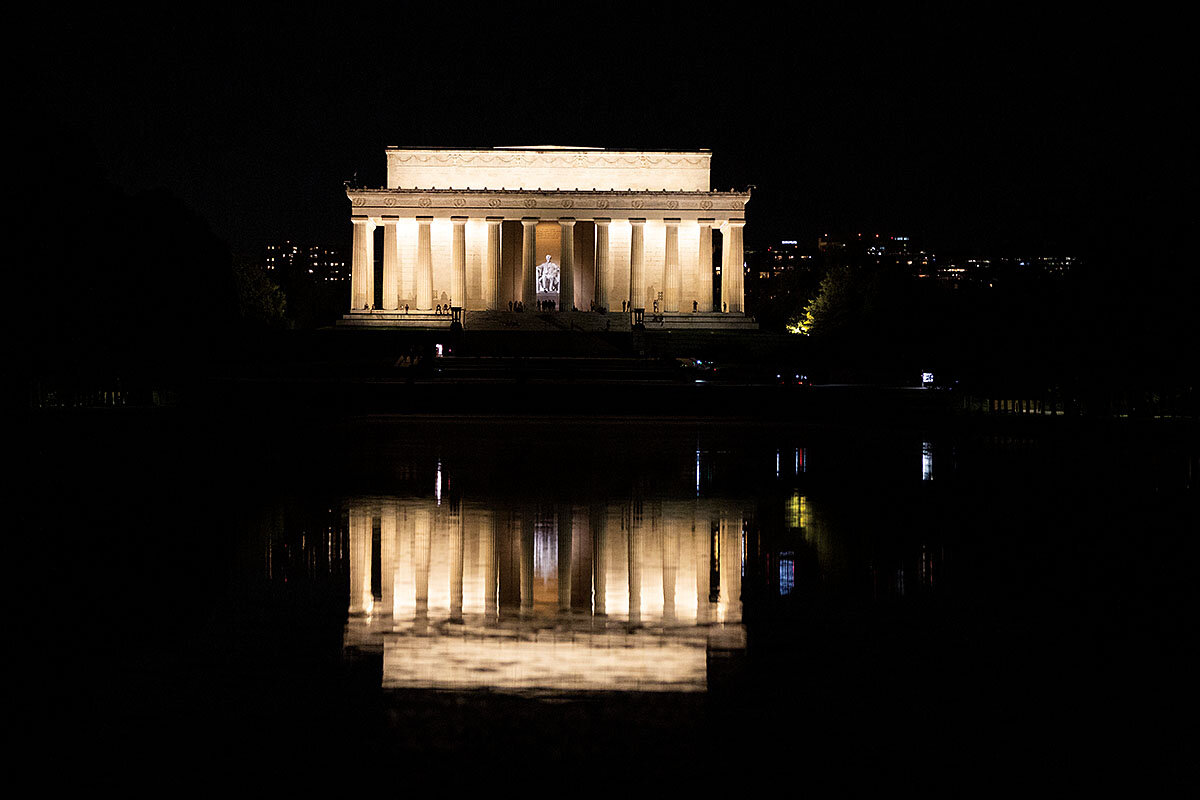
- Quick Read
- Deep Read ( 13 Min. )
-
By Michael S. Hopkins Correspondent
As the nation emerges from a historic pandemic, people are readying – yearning – to hit the road again. They’re buying plane tickets, booking hotel rooms, and pumping up their bicycle tires. Now, if they can just find that valve-stem needle in the garage.
We sent our reporter to Washington, D.C., to take the pulse of post-pandemic America on the kickoff of a prophesied season of adventure. Like elsewhere in the nation, Washington has been largely closed, its tourism industry devastated. Yet now the city is slowly reopening.
To gauge the mood, our writer undocked a Capital Bikeshare cycle (no needle necessary) and headed for one of the city’s signature attractions – the monuments along the National Mall. He wanted to see what Washington looked like after the closures, after last summer’s protests, after the January rioting on Capitol Hill.
Early signs of recovery are healthy. Despite the national political divisiveness, and despite some sites remaining closed to the public, school groups are stepping off buses again. Amid the national reckoning happening with America’s past, and with how historical injustices continue to play out today, these tourists still appreciate American history – the good, the bad, and the ugly.
Our writer found solace at the Lincoln Memorial, where he came to the realization that the statue has long watched over Washington, bearing witness to the ups and downs of the past year: “He is always here. He never rests, he is always waiting.” Moments are brief, he observes, but history is long.
8 monuments, 12 hours: What a reopening D.C. says about America
In the end, we cheated.
The assignment had been clear enough. One writer, one photographer, eight monuments, one day. Go. Take the pulse of late-pandemic Washington for a Memorial Day story about the prophesied return of summer travel. Will the district be back on vacation itineraries after its year of dread? Should it be? Take a day. See what it’s like.
But now it’s 5 a.m., the morning after our monumental day; 5 a.m., and the photographer and I are back on Washington’s streets in the black hush before dawn. We undock a pair of Capital Bikeshare cycles for two bucks a pop and are coasting again toward the Mall, toward daybreak, toward the Lincoln Memorial in spring air so soft the ride feels like floating. On 21st Street it’s all downhill, you don’t even pedal; at intersections we look for traffic but there isn’t any. We just keep gaining speed. We cross Constitution Avenue, curl up a slight rise under a canopy of elms, and all at once we see it – the 36 fluted columns, the radiant marble pavilion – the Lincoln Memorial, wide awake and white-lit against the black canvas of the sky. And we find exactly what we’re looking for.
A Capitol defense
This isn’t how things started. Two days earlier the photographer and I had flown to Washington, on a plane that no longer blocked seats for distancing, into a Reagan National Airport that felt as busy as ever.
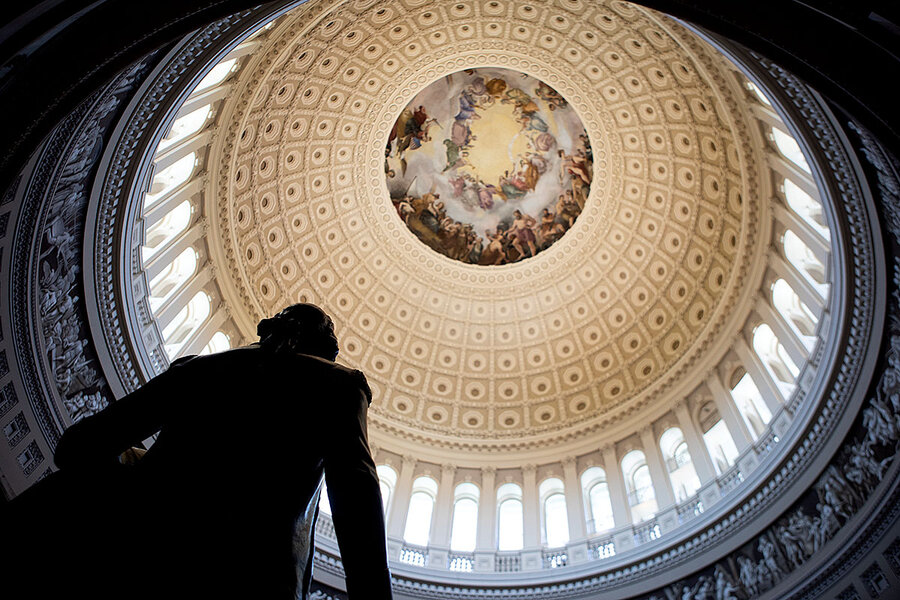
D.C., though, was not busy. That first afternoon, the day before our tour of the monuments, we visit the Capitol Building itself, curious to see the scene of the January crime. We bike there from Foggy Bottom (bikes are the perfect way around Washington), noting the scarcity of cars in a city where usually it’s hard to cross a street. We enter a Senate office building at the edge of the new security perimeter, pass through the first of innumerable guard posts with our press credentials, and make our way through underground tunnels to stairwells that will usher us into the main part of the Capitol.
The building is astonishingly empty. It’s a Monday, Congress isn’t meeting, and the public remains locked out. We pass doors and windows still covered in plywood after having been breached on Jan. 6. But that’s not what you notice with the usual throngs missing. What you notice is how unexpectedly flamboyant the Capitol is, how filled with color and ornament. The floors explode with pattern. The ceilings look like Versailles. As you climb steps under billboard-sized paintings, your feet slip into hollows made by 200 years of people traversing them before you. People whose names you know.
In the Rotunda, there is no one – no politicians or staffers racing back and forth towing journalists, no tourists milling in the gallery to gawk. The photographer has never seen it like this, and becomes quickly lost in taking pictures of the dome and the statues and the reflections on the tiles. There are always people here, she says. Always.
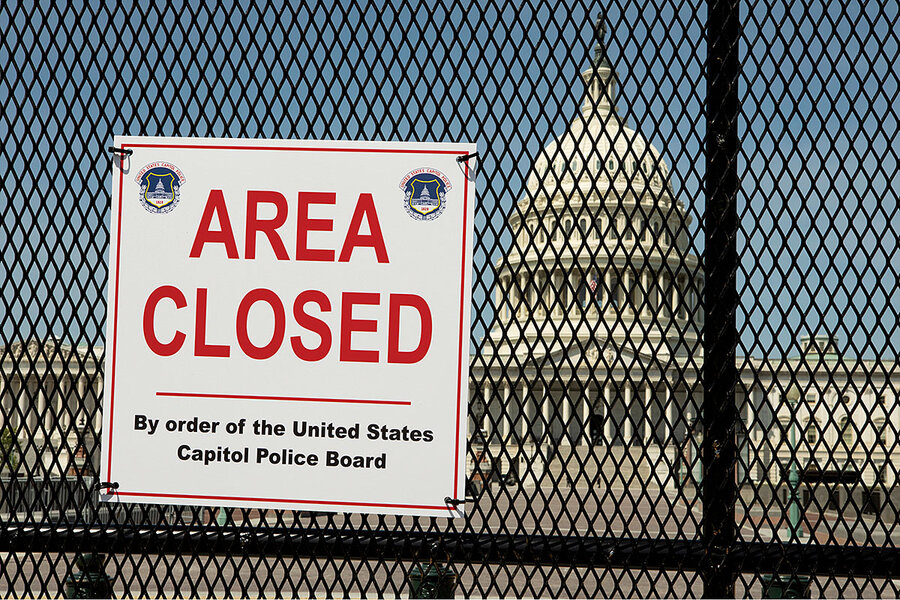
Of course, our current times are not like “always.” In 2020, Washington’s hospitality industry was devastated; its Smithsonian museums are just now reopening, its restaurants just now being permitted higher occupancy. But summer is coming, the pandemic is shrinking in the United States, and some travel forecasts predict that tourism is about to surge.
Will that surge include D.C.? Washington is the seventh most popular destination in the country. How will it be affected by its strict pandemic closures and last summer’s protests and this January’s riot – not to mention the atmosphere of divisiveness that from afar can seem like the capital city’s main line of work? Will travelers come back? What’s it like to visit Washington now?
Outside the Capitol we meet Jackie Gillen and her husband, Ernie Beyard, who take us for a walk with their dog Barkley. The couple live in the Capitol Hill neighborhood, which spreads east from its namesake building, and this walk is their routine: two blocks down the street, a slight jog around the Supreme Court, then across First Street to the Capitol’s parklike lawn. There people picnic or exercise or take selfies. There Barkley gambols and chases the surprisingly plentiful rats. (And no, this author will not be touching that metaphor.)
Except that none of those things can be done anymore, because the entire Capitol grounds – 58 acres designed by Frederick Law Olmsted – are now behind a fence. Erected in January, the fence is 7 feet high, made of black metal mesh, and is supposedly unscalable – its openings purposely too small for a toehold.
“At least the razor wire is gone,” Mr. Beyard says. In fact, he explains with relief, the security perimeter is now smaller than it was. Until February their whole neighborhood was blocked off, and residents had to pass through checkpoints like in a wartime green zone.
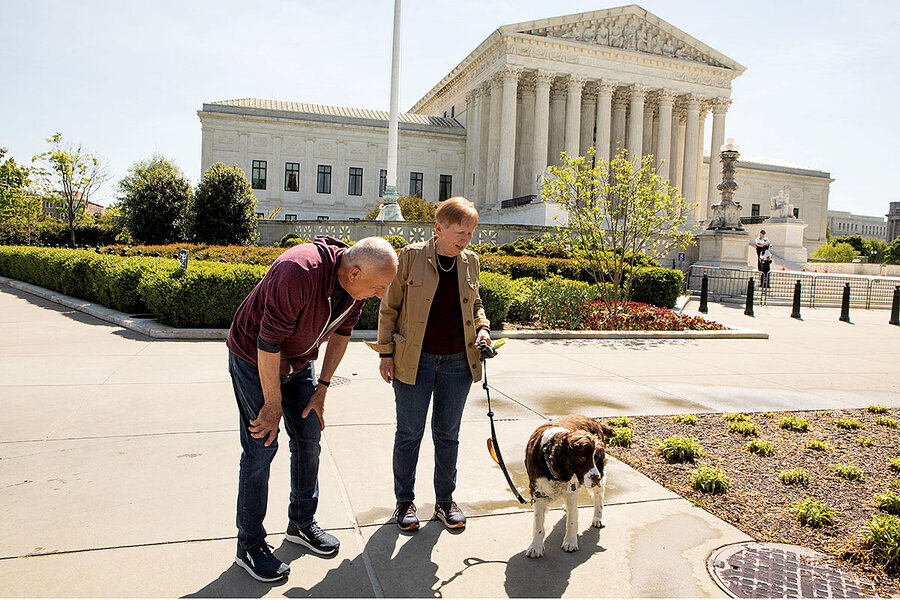
Still, here we are on First Street, looking at militarized fencing that also now surrounds the White House and adjacent Lafayette Square. We contemplate what it means when a government has to protect itself from its own citizens. But through their scrim of dismay, Ms. Gillen and Mr. Beyard gaze at the Capitol with fondness they can’t suppress. Ms. Gillen first arrived here just out of college in 1975 for a job as a legislative aide, and she remembers passing the lighted dome each night and being “filled with awe.” Now she says, despite everything, “I still am.”
So, is now a good time to visit Washington? “Definitely,” says Mr. Beyard. After all, this summer “won’t be as crowded.” Plus, the museums are reopening. The restaurants are returning to normal. The performing arts are coming back.
During our trip those amenities remain mostly shuttered. But the memorials? Most never closed.
It’s time to see them.
Brief moments, long history
We begin at the beginning, the Washington Monument. We pedal our bikes toward it over the pathways of the National Mall and then up the broad mound that lifts the enormous obelisk above the landscape, encircled by flags. The day is brilliant. The flags crack in the wind. From here you see everywhere, your eye skipping over the roofs of the low-built city. The sky above is like a bowl turned over.
On the monument’s plaza we meet Lowell Fry, a man so alive in his skin that he does little dance steps as he speaks; his hands flutter and swing. We ask, “Can you talk?” He replies, “Can you stop me?” and laughs through his face mask. Mr. Fry is an interpretive ranger for the National Park Service – each of D.C.’s memorials is an official national park – and he gives public talks while rotating daily among the sites as all the rangers do. He says the last year has been hard, of course, but he’s so sparkly that you’re not sure whether you believe him.
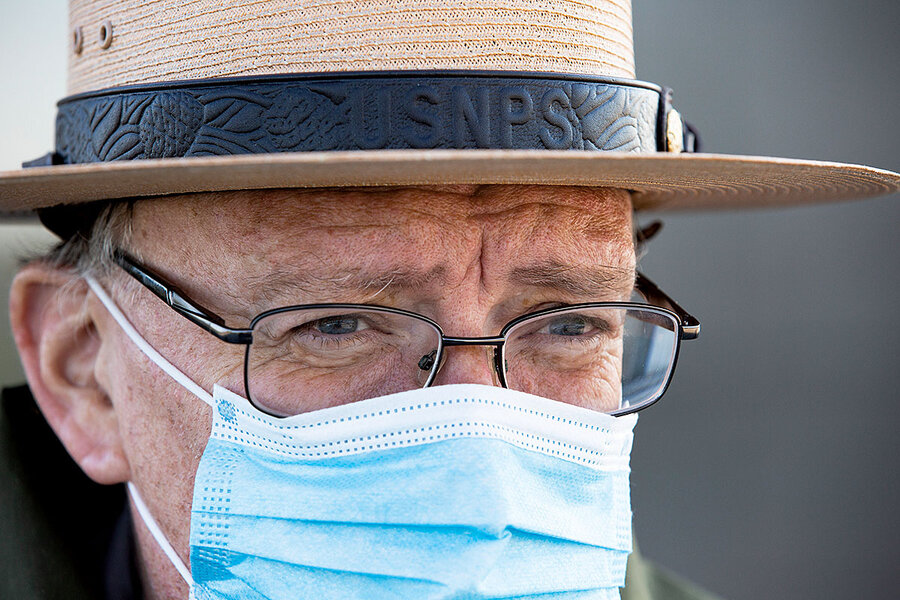
Visitor traffic is finally picking up – though you still can’t go inside the Washington Monument – and we ask if the tourists seem different. What do people seem to be seeking when they come to the monuments now, in the wake of Washington’s turbulent year, and the country’s? “Well, the questions they ask haven’t changed,” he says, “but maybe the history in these places offers something. I try to tell them that we have good history and we have bad history, both.” Maybe these places provide a kind of perspective, he says. Moments are brief. History is long.
“I like to tell the story about Zhou Enlai [then premier of China] and [President Richard] Nixon in the ’70s,” Mr. Fry says. “It’s when Nixon was visiting China, and at some point he says to Zhou, ‘Mr. Premier, what do you think has been the influence of the French Revolution?’ And Zhou answers, ‘Too early to say.’”
Mr. Fry looks at us, and nearly winks as he readjusts his ranger hat against the wind. “Could be apocryphal,” he stage-whispers.
The monument towers over us, uniquely geometric in a city of Doric columns and neoclassical fizz. That simplicity is its power, you realize. And you’re reminded that it wasn’t originally designed this way. The plan was for the obelisk to rise out of a classic Greek pavilion at its base; the sketches suggest a unicorn sunk in a wedding cake. Thankfully, money ran short, and people changed their minds.
From the Washington Monument, we head clockwise around the Tidal Basin, our bike tires crunching over exhausted cherry blossoms. We go to the Jefferson Memorial, the Franklin Delano Roosevelt Memorial, the Martin Luther King, Jr. Memorial. We linger. We amble up to fellow visitors and ask where they’re from, what they think, why they’re here. We take our time.
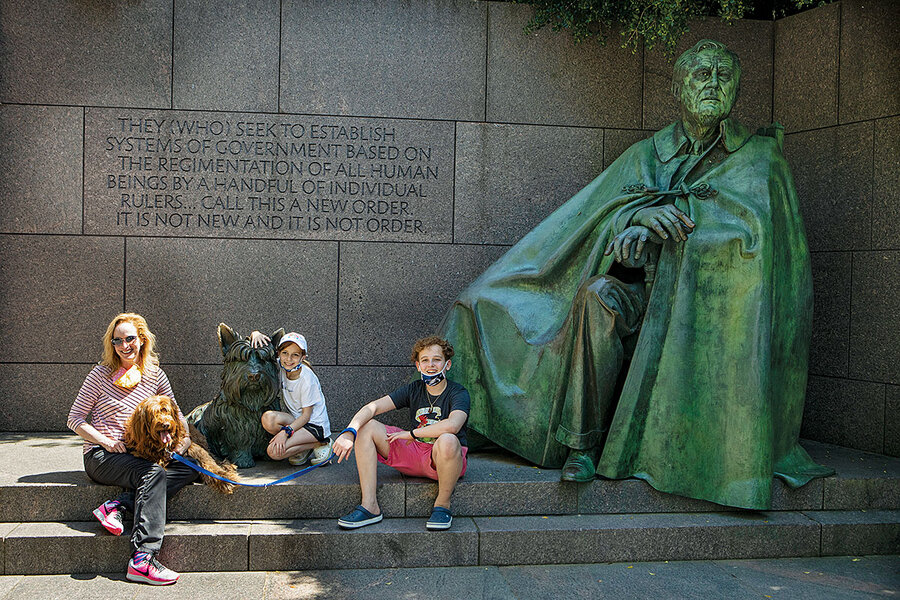
It’s quiet, but we meet people everywhere, and though they’re masked, none of them are focused on the pandemic anymore. We meet Valerie Arissol and Bryan Reifer from Dubai, United Arab Emirates; Ben Sherman from Virginia; Aisha Maundy from New Jersey with her son Christopher Maundy and Christopher’s daughter; and the Cook family from New Hampshire. We meet Washingtonian Jamar Moore and his little boy, Juelz – Juelz in his Wizards cap proudly posing with his dad in front of Dr. King emerging from his enormous “Stone of Hope.”
Why have they come? “I love history,” almost all of them say – even our history of wars, tragedies, injustices. It’s as though they’ve already heard one of Mr. Fry’s ranger talks. It reminds us of what matters, they say.
At the King monument, especially, it’s impossible not to be moved as person after person walks forward to lay hands on the colossal sculpture. Some touch their foreheads to it.
All day, impressions accumulate: There’s the way you enter the MLK memorial through a sliver of 30-foot granite like it’s a tight portal to something better – the memorial’s plaza then leading gently downhill to Dr. King’s likeness and its view over the cherry trees and across the glinting water to meet Jefferson and Washington and FDR.
There’s the FDR memorial’s unusual sylvan beauty, its sinuous procession of natural “rooms” defined only by groves of trees and blocks of nearly purple stones like the bricks of the pyramids. And always, there are the words – so many words, engraved to last, from so long ago and yet so prescient.
“In these days of difficulty, we Americans everywhere must and shall choose the path of social justice ... the path of faith, the path of hope, and the path of love toward our fellow man” (FDR, 1932).
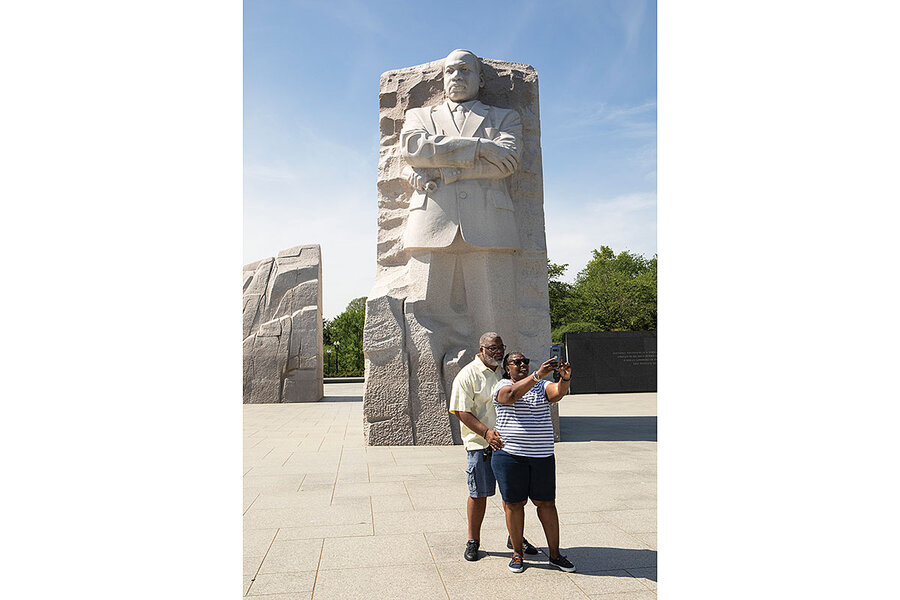
“If we are to have peace on earth, our loyalties must become ecumenical rather than sectional. Our loyalties must transcend our race, our tribe, our class, and our nation; and this means we must develop a world perspective” (MLK, 1967).
And of course, “The only thing we have to fear is fear itself” (FDR, 1933).
Slowly, we make our way to the National Mall’s hallowed western end, home to the Korean War Veterans Memorial, the Vietnam Veterans Memorial, and the Lincoln Memorial. At the Vietnam memorial, workers are repairing cobblestones beside the famous ebony wall, speaking Spanish, stretching caution tape for safety. We read messages people have left along the wall below the names, and we look at the little American flags stuck into inverted foam cups. Here and there are artifacts left like tributes. We see a carefully placed pair of boots – its uppers folded over, its polished leather creased from the feet of the man who had worn them. It’s quiet here.

At the Korean memorial, as dusk comes, low-angled floodlights throw shadows behind each of the 19 stainless steel statues on patrol among knee-high junipers. Their packs look heavy; they look cold. They are trudging uphill.
By the time we reach the Lincoln it is evening, but the site is still flooded with people. There are school groups that have stepped off buses. There are people of seemingly every nationality. There are families, couples, visitors from out of town. Several of them ask the photographer if she would use their phones to frame a picture of them in front of the statue. She does.
It gets late, but people don’t leave. Or if they do, others replace them. Some walk around the memorial’s columned plinth to sit on its western side overlooking the Potomac and the bridge to Arlington National Cemetery. In the distance you can see JFK’s eternal flame.
As we look out, airplanes skim past us over the river toward Reagan National, descending to land. And the photographer tells me a story.
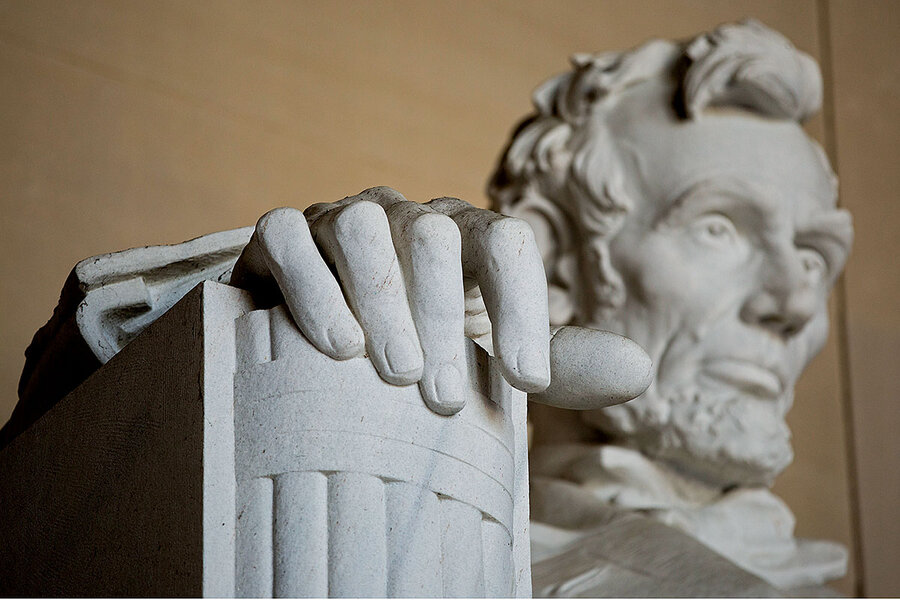
As a student in the late 1970s, she went to the Soviet Union to study. Kiev, Moscow, Leningrad. She remembers a nation of unrelieved gray, so gray, and how people knew Americans by their well-made shoes and facial expressions – in the Soviet Union no one smiled.
She remembers coming back to the States on Pan Am. When the plane left the runway in Moscow the passengers applauded. And later when the captain announced that the flight had cleared Soviet airspace, they applauded again.
That flight – just like the ones we’re watching now from the Lincoln – returned to Washington, where the photographer lived. Like now, it was nighttime. And she remembers the feeling of floating down in the dark, the earth below growing nearer, the illuminated city growing brighter. Until suddenly there it was right beside her, just outside the cabin window: her city’s extravagant beauty – its monuments alive, the Lincoln and Jefferson close enough to touch, their reflections shining on the river. And she remembers thinking of what it all stood for, and feeling proud, and thinking vaguely that maybe there are things it’s hard to appreciate unless you’re away for a while.
“Corny,” she says to me now. Still, she remembers tears running down her cheeks, and someone beside her saying, “Miss? Miss, are you OK?”
“Yes,” she remembers replying. “Yes, yes. Sorry. It’s just – I’m ... I’m home.” She remembers gesturing somehow, in that way you do when it’s impossible to encompass all that’s happening outside you, inside you. She remembers giving up trying to express it, and looking back out the airplane window. And saying again, “This is my home.”
As if to herself.
Whispers from the stone
We cheated, as previously confessed. We had had our day – our 12 hours to take in all the monuments – but now it’s the morning after and we’re back at the Lincoln Memorial in the dark before sunrise.
We dock our bikes and walk to the terrace at the memorial’s foot. We look up.
Later – 7 a.m., 7:30 – this place will teem. There will be runners in ones and twos and fours, passing cyclists with headlamps still on, pairs strolling with coffee, women doing yoga on rolled-out mats, and hobbyists with their cameras and tripods and gear bags waiting for the first peeking rays of horizontal sun. There will be a couple posing for what have to be engagement pictures, he in a dove-gray sport coat, she in a tailored white suit, in each shot crossing her ankles just so.
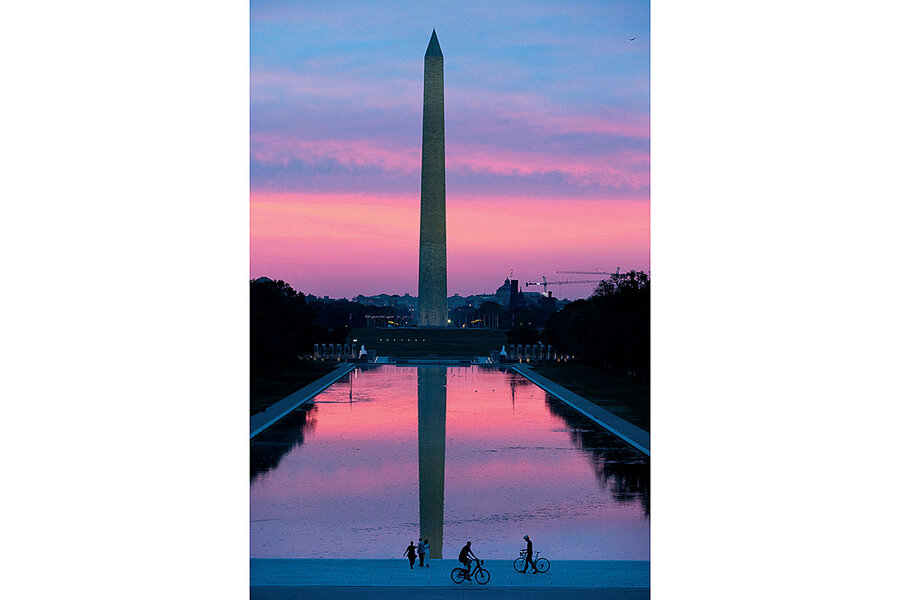
Were it not for the face masks, you wouldn’t know there is a pandemic, or ever had been. You would have to work hard to remember that behind us has been a year with protests and mobs and new barriers erected by the state. Here, today, it could be any year. It could be every year.
But that teeming activity would come later. Now, on the lower terrace, it’s still night – and apart from a solitary tourist with his tripod, we’re alone. Gradually we hear birds. In front of us are 58 steps to the pavilion’s lofted floor. We climb.
At the top, inside, is Lincoln. For once, you are alone with him. It’s hard to capture how it feels. And it comes to you, in a realization that seems oddly novel but is obvious as dawn, that he is always here. He never rests, he is always waiting. Alone, he speaks to you – or maybe you to him. And you can’t help thinking: He must have doubted himself every day. Every day he must have lamented the choices he was offered, the things his country needed him to do.
You think: He is always here, looking out from his perch. For 100 years he has seen everything that happened in this park, on that Mall, at that Capitol. You imagine the history it amounts to, and think again of Dr. King’s words that you read just yesterday carved forever on a wall. “The arc of the moral universe is long, but it bends toward justice.” You hope he was right. You think: Moments are brief, history is long. You wonder what Lincoln knows.
You think: His eyes never close. Here, in all weathers, through nights and mornings and winters and springs, he peers east down the steps, over the reflecting pool, past the Washington Monument, and beyond to the Capitol – the Capitol whose dome is obscured by Washington’s obelisk but whose wings in the afternoon will gleam in the westering sun, their colonnades and filigree stretching both north and south like great ancient arms flung open and wide.
He watches everything, you realize. Everything, that is, but the fence so recently installed. From where Lincoln sits, you realize, the fence is too small to see.

Can freight trucks pull their weight in lowering carbon emissions?
Progress in battery technology is opening the way for even long-haul heavy trucks to go electric. Emphasis on the word heavy - these vehicles can weigh upward of 15 tons. A key question now is the need for amped-up charging stations to help them roll.

- Quick Read
- Deep Read ( 5 Min. )
-
By Jason Thomson Correspondent
Freight trucks account for 7% of global energy-related carbon dioxide emissions, double the role of airplanes. With that in view, governments are increasingly setting targets for shifting commercial trucking – from small delivery trucks up to 18-wheelers – away from fossil fuels.
The big challenge ahead is that an electric revolution in freight hauling will require investing in high-powered charging stations – and even upgrades to power grids to make those possible.
The heaviest freight trucks weigh upwards of 15 tons, compared with one or two for a typical car. This means the batteries are far more power-hungry.
Yet confidence in an electric future abounds, with legacy truck-makers such as Volvo, Daimler, and Kenworth rolling out electric models alongside Tesla. The trend is driven by technological advances that have dramatically lowered the cost of lithium-ion batteries.
“It absolutely will require upgrades” to the power grid, says Jessie Lund of RMI, a nonprofit that promotes a clean-energy economy. But “we’re not talking about every truck in the continent electrifying tomorrow, so I have a little faith that [U.S.] utilities will be able to plan for it and make the necessary upgrades.”
Can freight trucks pull their weight in lowering carbon emissions?
“It blows my mind. I hope it’ll blow yours.”
So said Elon Musk, CEO of Tesla, after leaping out of his company’s new offering onto a stage, greeted by adoring applause from a sea of fans, back in 2017.
The vehicle in question – while electric, of course – was a heavy truck, and Mr. Musk extolled it as supposedly superior to the diesel-powered 18-wheelers currently crisscrossing our continents. Today the first Tesla Semis are close to rolling off the production line. Competitors from firms including Volvo and Scania are already on the roads.
Given the loads of freight they pull and the distances they cover, you might think semitrailer trucks would be a far-off milestone in a global transition toward electrified transport. Yet advancing technology is fast putting the idea of decarbonizing overland freight traffic within reach. And the environmental benefits are compelling.
Road freight transport accounts for 7% of global energy-related carbon dioxide emissions, double that of the aviation sector, as well as some 20% of the world’s oil demand. With that in view, governments are increasingly setting targets for shifting commercial trucking – from buses and small delivery trucks up to 18-wheelers – away from fossil fuels. A band of green-minded U.S. states, for example, is aiming for 30% of commercial-truck sales be for zero-emissions vehicles by 2030.
The big challenge ahead is that an electric revolution in freight hauling will require some big investments in vehicle-charging stations – infrastructure that is now in its infancy, transportation experts say.
“It absolutely will require upgrades” to electric-utility systems, says Jessie Lund, a senior associate in the carbon-free mobility program at RMI, a nonprofit that promotes a clean-energy economy. But “we’re not talking about every truck in the continent electrifying tomorrow, so I have a little faith that [U.S.] utilities will be able to plan for it and make the necessary upgrades.”
What’s clear, though, is that this next wave of electric transportation is different from the tide of passenger electric vehicles (EVs) currently being brought to market.
“The narrative that’s been growing in the past couple of years to deal with climate change is basically to electrify everything, which I think is great,” says Olle Olsson, senior research fellow at the Stockholm Environment Institute, and co-author of a recent study on the feasibility of heavy battery-electric trucks. “But it also puts massive demands on the power infrastructure, and there are still some challenges there as to how to build it.”
Are power grids ready?
The heaviest weigh upwards of 15 tons, compared with one or two tons for a typical car. This means the batteries are far more power-hungry, which, in turn, means the chargers either have to be plugged in for many more hours – or they need to provide higher levels of electricity.
For a good many commercial vehicles, one overnight charge may be enough for the next day’s work. But power grids are already facing new demands in transitioning to renewable energy, as well as the burgeoning fleet of passenger EVs. Some experts worry that grids may require substantial redevelopment to cope. Others don’t see the hurdles as daunting.
“I think it’s fewer upgrades than a lot of people think. I think even [the utility companies] have been surprised at how a lot of it is capable of supporting these vehicles today,” says Ms. Lund, who specializes in emissions reductions from heavy-duty transport.

Indeed, the shift to electric trucks is still in its nascent stages. Volvo Trucks, for instance, has delivered just a single specimen of its FL Electric to date in the whole of the United Kingdom, and expects to sell a total of around 10 this year in the U.K./Ireland market, a company spokesman says by email.
Yet confidence in an electric future abounds, with truck-makers such as Volvo, DAF, Scania, Daimler, and Kenworth all rolling out EV models. Volvo has even announced a target of 50% of its European truck sales being EV editions by 2030.
A road paved by technology
This confidence has to do, in part, with the technological advances of recent years. Ms. Lund says lithium-ion batteries – the dominant kind in EVs – have fallen in cost by around 90% in the past decade.
In lockstep with falling costs, the energy density achievable in these batteries has gone in the opposite direction, seeing constant improvements. For trucks, this is vital, as higher energy density means smaller batteries – and that means less weight and more space for goods.
Then there is the charging side. Fast chargers for passenger EVs generally range from 50-150 kilowatts, or even as high as 350kW. These levels can be just fine to charge heavy trucks if they’re able to sit still for many hours. When long-haul trucks need to power up mid-journey, far more powerful chargers are going to be needed.
“First of all, it’s technically possible,” says Mark Duvall, director of electrification and customer solutions at the Electric Power Research Institute (EPRI.) “Very high-powered charging does present a series of challenges, and they’ll be overcome.”

With chargers in development capable of delivering as much as 3 megawatts (3,000 kW) there are groups already busy at work seeking to surmount some of the associated difficulties. CharIN, a Berlin-based association of more than 200 organizations across the globe involved in e-mobility, set up its Megawatt Charging System initiative in 2018, seeking standards for charging heavy-duty vehicles.
Meanwhile in the U.S., a West Coast Clean Transit Corridor Initiative among electric utilities is envisioning how these chargers could be distributed at 50-mile intervals along routes in California, Oregon, and Washington state. California is home to additional similar initiatives.
California’s ambitious goal
California is a hotbed of activity because of its stringent regulations: Last year the California Air Resources Board implemented a directive requiring more than 55% of truck sales to be of zero-emissions models by 2035, rising to 100% a decade after that.
“Policies have been big drivers for everything we’ve accomplished to date,” says Mr. Duvall of EPRI, who has been working on EVs for almost three decades. “Given that most new technologies don’t start off being cost-competitive, or cost-superior to the incumbent technology, it’s those policy incentives that accelerate the existing market.”
A whole other option for zero-emissions freight hauling – power from hydrogen fuel cells – has gotten a boost from both Toyota and the startup Nikola. Toyota rolled out its prototype heavy-duty truck in December to haul cargo around the ports of Los Angeles and Long Beach.
Mr. Duvall says he’s always supported exploring various technologies rather than eliminating options early in the game. But, with hydrogen requiring its own infrastructure, he adds that “it’s very hard to dethrone an existing technology … . So, 10 years ago, or 15 years ago, before EVs were commercialized, before hydrogen vehicles were commercialized, you could argue that neither technology had that advantage; now, they’re in very different places.”
Editor's note: A sentence in this article was updated after publication so that one group is mentioned by its preferred name, RMI.

Points of Progress
Counting bees, growing trees: How people’s efforts build back environments
We visit Ecuador, Sweden, Uganda, Indonesia and the Netherlands in our latest roundup of how people are improving the world. For example, Amsterdam has set up hotels for bees. (Does it come with a Queen suite?)
Counting bees, growing trees: How people’s efforts build back environments

One key to getting work done is buy-in. In this week’s spotlight on positive global news we feature Ecuador, where municipalities started a successful conservation program by asking people how much they would be willing to pay for their water.
1. United States
The entire West Coast now has access to early earthquake warnings after Washington state was added to the mobile alert system. First launched in Los Angeles, the system began notifying cellphone users in 2018. Because modern telecom systems can send messages faster than shock waves move through the ground, the alerts offer users crucial seconds to prepare for the shaking – enough time to find shelter or to drop, cover, and hold on.
More than 50 million people living in the most earthquake-prone region of the country now have access to the early alerts, which are issued automatically to Android operating systems or through a number of mobile apps, such as MyShake and QuakeAlertUSA. The U.S. Geological Survey is also working to complete its seismic station network by late 2025, adding sensors to rural parts of the West Coast and ultimately improving alert times.
Los Angeles Times, USGS

2. Ecuador
A pilot program in southern Ecuador is incentivizing residents to conserve water and protect the environment. In 14 municipalities where climate change and deforestation have affected water quality and exacerbated shortages, the Regional Water Fund of Southern Ecuador (FORAGUA) is either buying land or entering multiyear agreements with landowners to turn their property into conservation areas. In El Pangui’s water catchment area, for example, it’s convinced several cattle farmers to rewild their pastures and grow a local fruit elsewhere that produces more income. The program is funded by a fee on water consumption, which is partly determined by how much residents are willing to pay and generally amounts to about $1 per month for an average family.
FORAGUA, founded in 2008, is the first water fund in the country to bring together municipalities of different sizes and resource capacities. The group provides equipment, funds, and expertise to local environmental departments to develop sustainable-use ordinances and conservation programs that work for local communities and the region more broadly. So far, FORAGUA has restored 3,700 acres of land and put 833,000 acres under conservation. By 2030, the group hopes to serve 39 municipalities and protect 1.48 million acres.
Mongabay
3. Sweden
The Swedish city of Malmö has curbed gun violence with help from a U.S. strategy. Malmö adopted the Group Violence Intervention (GVI) approach after a surge of gang violence in 2017 resulted in 65 shootings.
Known as Operation Ceasefire when first developed in the 1990s in Boston, the program is now seeing gun violence decline annually in the Scandinavian city, with 20 shootings recorded last year. In March 2021, authorities extended the GVI program, known as Sluta Skjut (Stop Shooting), for another three years.
A major element of GVI is the “call-in,” in which rival gang members out on parole must gather and listen to a series of speakers – a nurse, imam, etc. – explain how they’ve been affected by gang-related shootings. The hope is that these young people will bring the stories back to their networks and discourage others from picking up a weapon. As the program gets more publicity, GVI coordinator Rebeca Persson has also received more requests from people who want to leave the criminal world entirely, but need help starting fresh. In 2020, her organization helped 14 ex-members relocate to new cities and supported 49 men in leaving their gangs.
The Local, The Telegraph
4. The Netherlands
The Netherlands’ latest bee census shows the national pollinator program is succeeding in stabilizing urban bee populations. Announced in 2018, the strategy includes 70 initiatives to increase bees’ nesting sites and food supply following a decadeslong decline in native bee populations. Of the country’s 360 native bee species, more than half are endangered. With much of the decline stemming from economically important agricultural activity, including the clearing of bee-friendly landscapes for farming, many initiatives have focused on urban areas. Amsterdam, for example, has set up “bee hotels” – tall, cavity-packed structures where bees can find refuge – and replaced grass with native flowering plants on public lands.

Thousands of volunteers recently counted and identified bees in their gardens for the fourth national census. Organizers plan to collect five years’ worth of data before making definitive conclusions, but the 2021 results – an average of 18 to 20 bees and hoverflies spotted per garden, consistent with previous years – suggest the pollinator strategy is working.
The Guardian
5. Uganda
Solar-powered streetlights are helping Uganda’s second-largest city improve public safety and save money. Due to aging equipment, poor maintenance, and high electricity costs, much of Jinja was living in darkness in 2016. The city installed more than 100 solar lights, powered by photovoltaic panels and batteries, over three years. The new equipment was 25% cheaper to install than traditional city lighting, and maintenance costs have been reduced by up to 60%. The reliable lighting has allowed businesses to thrive with longer hours of operation, and locals say the tourism sector was also growing before the pandemic.
With financial and technical support from a World Bank program, Jinja has developed a master plan for infrastructure that includes a citywide rollout of solar lights. But the impact of its success may reach further. Many of Africa’s largest cities have incorporated informal settlements without power grid coverage, and they are eyeing solar power – with lessons learned in Jinja – as a sustainable way to boost economic opportunity.
Bloomberg
6. Indonesia
Deforestation has declined for the fourth consecutive year in Indonesia, as the island nation rethinks its approach to forest protection. Many of the country’s current policies stem from the 2015 Southeast Asia haze crisis, when Indonesian forest fires covered neighboring countries in a thick smoke, resulting in loss of life and environmental devastation. Governments and businesses have since worked together to reduce forest clearing for commodities such as palm oil, while also strengthening protections of carbon-absorbing mangroves and peatlands. This includes a temporary ban on new palm plantations, established in 2018 and lasting three years.
Home to the world’s third-largest tropical forests, Indonesia has a multilevel approach that has allowed the country to drop from third to fourth place on the Global Forest Watch rankings for tropical forest loss. Experts from the United Nations Environment Program say the new clearance restrictions “have certainly been critical” in slowing deforestation, although falling palm oil prices may also be a factor.
Thomson Reuters Foundation
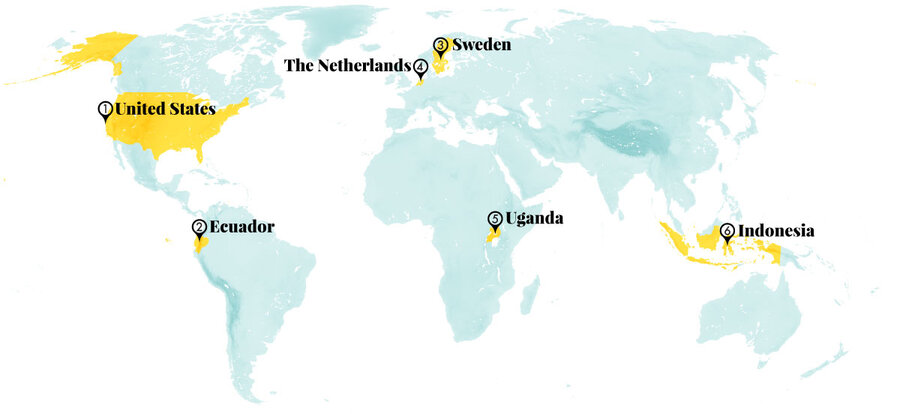
Other headline stories we’re watching
(Get live updates throughout the day.)The Monitor's View
A dictator’s brazen act against a truth-teller
- Quick Read
- Deep Read ( 2 Min. )
-
By the Monitor's Editorial Board
Four months ago, Pavel Latushka, a dissident fighting a dictatorship in Belarus, made a prediction: “Those who avoid transparency and responsibility inside the country are likely to act in a way that may threaten international peace and security,” he told an informal meeting of the U.N. Security Council.
On May 23, his warning came true. The repressive government of Alexander Lukashenko used a fighter jet to force an Irish airliner flying over Belarus to land in order to arrest Roman Protasevich, a journalist in exile who operated a news site about Belarus. More than 160 innocent people on the flight were put in danger, and an international norm for civil aviation was violated.
The incident has led to increased foreign sanctions on the regime. It also has highlighted a critical role for many of Belarus’ truth-tellers, especially the few journalists who have not been arrested or forced into exile since protests erupted after a fraudulent election last year. The persecution of media outlets has only put a spotlight on the regime’s growing unpopularity and its fear of revelations about harsh tactics it uses against pro-democracy activists.
A dictator’s brazen act against a truth-teller

Four months ago, Pavel Latushka, a dissident fighting a dictatorship in Belarus, made a prediction: “Those who avoid transparency and responsibility inside the country are likely to act in a way that may threaten international peace and security,” he told an informal meeting of the U.N. Security Council.
On May 23, his warning came true. The repressive government of Alexander Lukashenko used a fighter jet to force an Irish airliner flying over Belarus to land in order to arrest Roman Protasevich, a journalist in exile who operated a news site about Belarus. More than 160 innocent people on the flight were put in danger, and an international norm for civil aviation was violated.
The incident has led to increased foreign sanctions on the regime. It also has highlighted a critical role for many of Belarus’ truth-tellers, especially the few journalists who have not been arrested or forced into exile since protests erupted after a fraudulent election last year. The persecution of media outlets has only put a spotlight on the regime’s growing unpopularity and its fear of revelations about harsh tactics it uses against pro-democracy activists.
An estimated two-thirds of Belarusians relied on tut.by, the main independent news in the country – until it was shut down May 18. At universities, hundreds of students have been detained for speaking out against the regime. Many other people, even those who simply displayed the white-red-white flag of the opposition, have suffered. “Society still insists on its agenda. Belorussian society has shown that it can surprise,” stated political analyst Andrey Yahoraw.
People in Belarus are doing what the late Czech dissident Vaclav Havel advised during the days of the Soviet Union – “live in truth.”
“Every day we show to the whole world that we are still here, that we are fighting,” exiled opposition leader Sviatlana Tsikhanouskaya told the U.S. Congress in March. “We will achieve truth and freedom,” she said, thanks to “all honest journalists, doctors, human rights defenders, volunteers and all brave Belorussians.”
The big street protests of last year have ended, a result of mass arrests and the pandemic. But now the regime’s brazen act of forcing down a commercial airliner to arrest one journalist has revealed its isolation and paranoia. “There is no need for mass protests,” wrote blogger Syarhey Satsuk. “One drop after another will do the job more successfully than a big wave of turbulent water.”
Truth works like that, eroding the lies of an authoritarian regime and forcing it to lash out in strange ways, such as intercepting an airliner. Those on the side of truth can easily predict such events.

A Christian Science Perspective
Each weekday, the Monitor includes one clearly labeled religious article offering spiritual insight on contemporary issues, including the news. The publication – in its various forms – is produced for anyone who cares about the progress of the human endeavor around the world and seeks news reported with compassion, intelligence, and an essentially constructive lens. For many, that caring has religious roots. For many, it does not. The Monitor has always embraced both audiences. The Monitor is owned by a church – The First Church of Christ, Scientist, in Boston – whose founder was concerned with both the state of the world and the quality of available news.
Embracing change
- Quick Read
- Read or Listen ( 2 Min. )
-
By Larissa Snorek
Sometimes change can seem scary. But recognizing that God’s goodness is constant and unchanging enables us to approach changes in circumstance with peace of mind.
Embracing change
Often, with change comes uncertainty. As we wonder what life will look like after the pandemic, there are many questions. Yet we can embrace constructive change moment by moment when we are clear about what doesn’t change – the constancy of good.
Even as the form of our experience changes from day to day, year to year, the substance of the actual good of our lives never changes, because it has its source in the unalterable nature of God as divine Love and Life.
The book of Ecclesiastes in the Bible says, “To every thing there is a season, and a time to every purpose under the heaven” (3:1). Despite how often we tend to resist change, it is actually natural to adapt to changes that come with a new season or a renewed purpose. Fundamentally, the effect of Christian Science “is to stir the human mind to a change of base, on which it may yield to the harmony of the divine Mind” (Mary Baker Eddy, “Science and Health with Key to the Scriptures,” p. 162). This Science of Christ invigorates and clarifies our understanding of the spiritual reality of Life and its permanence.
Then the right sense of progress for any endeavor emerges and enables us to see more clearly our own unique way to contribute or participate. Constructive, spiritual change occurs in our consciousness to bring healing and transformation to challenging situations.
This change is continual and inevitable when we’re striving to stay spiritually awake. Then, no change can trick us into feeling separate from the constancy of good sourced in God, or from one another.
Looking deeply into the spiritual substance of our lives, we find that true goodness is unchanging, and is never at the mercy of circumstances. Acknowledging this fact, we can embrace the flow of change with grace, equanimity, and unity.
Adapted from an editorial published in the May 24, 2021, issue of the Christian Science Sentinel.

A message of love
Honoring George Floyd
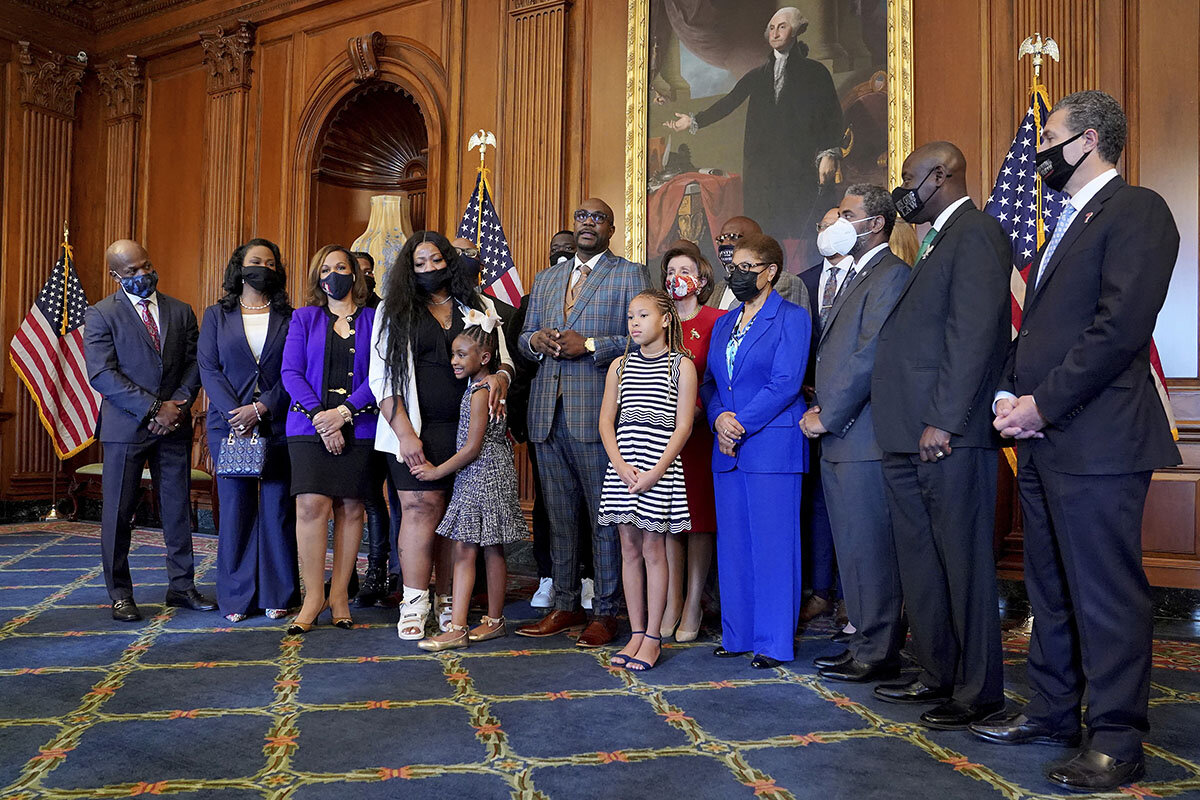
A look ahead
That’s our package of new stories for today. But here’s one more for your consideration: On a day when the world is remembering the death of George Floyd, check out our recent magazine cover story about how a riot-damaged neighborhood in Minneapolis rebuilt itself on a foundation of racial justice.




